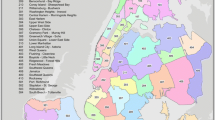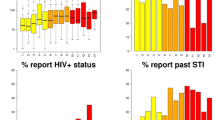Abstract
Gay, bisexual, and other men who have sex with men (MSM) represent more new HIV infections than all other at-risk populations. Many young black MSM belong to constructed families (i.e., the house ball community, gay families, and pageant families) which are often organized in a family structure with members referred to as parents and children. Many constructed families are associated with a family surname which is informally adopted by members. In some cases, however, constructed families do not identify with a collective family name. In 2014, 553 MSM were recruited through venue-based time-space sampling during the National HIV Behavioral Surveillance (NHBS) in New Orleans to complete a structured survey and HIV test. Black, Latino, and other race MSM were more likely to belong to constructed families in comparison to white MSM. In addition, participants who belonged to constructed families with a family name were more likely to engage in protective behaviors including wearing condoms at last sexual intercourse. Overall, younger, white MSM who did not belong to any social groups were more likely to engage in at least one risk behavior. These findings significantly contribute to understanding variations in HIV risk behavior among members of constructed families.
Similar content being viewed by others
References
CDC. Diagnosed HIV infection among adults and adolescents in metropolitan statistical areas—United States and Puerto Rico, 2011. Surveillance Suppl Report. 2013;18(8):1–87.
CDC. HIV Surveillance Report, 2014: diagnoses of HIV infection in the United States and dependent areas. vol.26. 2015; Available at: http://www.cdc.gov/hiv/pdf/library/reports/surveillance/cdc-hiv-surveillance-report-us.pdf. Accessed 3/3, 2016.
CDC. HIV Surveillance Report, 2013; vol. 25. 2015; Available at: http://www.cdc.gov/hiv/pdf/library/reports/surveillance/cdc-hiv-surveillance-report-vol-25.pdf. Accessed 3/2, 2016.
LADHH. Louisiana HIV, AIDS and Early Syphillis Surveillance Quarterly Report. vol. 13, No.4. 2015; Available at: http://www.hiv411.org/files/File/Fourth%20Quarter%202015%20HIV%20and%20Syphilis%20Report.pdf. Accessed 3/3, 2016.
Murrill CS, Liu KL, Guilin V, Colon ER, Dean L, Buckley LA, et al. HIV prevalence and associated risk behaviors in New York City’s house ball community. Am J Public Health. 2008;98(6):1074–80.
Sanchez T, Finlayson T, Murrill C, Guilin V, Dean L. Risk behaviors and psychosocial stressors in the New York City house ball community: a comparison of men and transgender women who have sex with men. AIDS Behav. 2010;14(2):351–8.
Parkin R, Stone L. Kinship and family: an anthropological perspective. Oxford: Blackwell Publishing Ltd; 2004.
Chatters L, Taylor R, Kody R. Fictive kinship relations in black extended families. J Comp Fam Stud. 1994:297–74.
Weston K. Families we choose: lesbians, gays, and kinship. 1st ed. New York: Columbia University Press; 1991.
Schneider D. American kinship: a cultural account. 2nd ed. Chicago: University of Chicago Press; 1980.
Oswald RF. Resilience within the family networks of lesbians and gay men: intentionality and redefinition. J Marriage Fam. 2002;64(2):374–83.
Holloway IW, Traube DE, Kubicek K, Supan J, Weiss G, Kipke MDHIV. Prevention service utilization in the Los Angeles house and ball communities: past experiences and recommendations for the future. AIDS Educ Prev. 2012;24(5):431–44.
Lewin E. Lesbian and gay kinship: Kath Weston’s “families we choose” and contemporary anthropology. Signs. 1993;18(4):974–9.
Muraco A. Intentional families: fictive kin ties between cross-gender and different sexual orientation friends. J Marriage Fam. 2006;68:1313–25.
Kelly JA, St Lawrence JS, Diaz YE, Stevenson LY, Hauth AC, Brasfield TL, et al. HIV risk behavior reduction following intervention with key opinion leaders of population: an experimental analysis. Am J Public Health. 1991;81(2):168–71.
Kelly JA. Popular opinion leaders and HIV prevention peer education: resolving discrepant findings, and implications for the development of effective community programmes. AIDS Care. 2004;16(2):139–50.
Kubicek K, Beyer WH, McNeeley M, Weiss G, Omni LF, Kipke MD. Community-engaged research to identify house parent perspectives on support and risk within the house and ball scene. J Sex Res. 2013;50(2):178–89.
Phillips G 2nd, Peterson J, Binson D, Hidalgo J, Magnus M, YMSM of color SPNS Initiative Study Group. House/ball culture and adolescent African-American transgender persons and men who have sex with men: a synthesis of the literature. AIDS Care. 2011;23(4):515–20.
Kipke MD, Kubicek K, Supan J, Weiss G, Schrager S. Laying the groundwork for an HIV prevention intervention: a descriptive profile of the Los Angeles house and ball communities. AIDS Behav. 2013;17(3):1068–81.
Dickson-Gomez J, Owczarzak J, St Lawrence J, Sitzler C, Quinn K, Pearson B, et al. Beyond the ball: implications for HIV risk and prevention among the constructed families of African American men who have sex with men. AIDS Behav. 2014;18(11):2156–68.
Allen DR, Finlayson T, Abdul-Quader A, Lansky A. The role of formative research in the national HIV behavioral surveillance system. Public Health Rep. 2009;124(1):26–33.
Lansky A, Sullivan PS, Gallagher KM, Fleming PLHIV. Behavioral surveillance in the U.S.: a conceptual framework. Public Health Rep. 2007;122(Suppl 1):16–23.
MacKellar DA, Gallagher KM, Finlayson T, Sanchez T, Lansky A, Sullivan PS. Surveillance of HIV risk and prevention behaviors of men who have sex with men—a national application of venue-based, time-space sampling. Public Health Rep. 2007;122(Suppl 1):39–47.
Gallagher KM, Sullivan PS, Lansky A, Onorato IM. Behavioral surveillance among people at risk for HIV infection in the U.S.: the national HIV behavioral surveillance system. Public Health Rep. 2007;122(Suppl 1):32–8.
Lansky A, Drake A, DiNenno E, Lee CWHIV. Behavioral surveillance among the U.S. general population. Public Health Rep. 2007;122(Suppl 1):24–31.
Sullivan PS, Peterson J, Rosenberg ES, Kelley CF, Cooper H, Vaughan A, et al. Understanding racial HIV/STI disparities in black and white men who have sex with men: a multilevel approach. PLoS One. 2014;9(3):e90514.
Horne SG, Levitt HM, Sweeney KK, Puckett JA, Hampton ML. African American gay family networks: an entry point for HIV prevention. J Sex Res. 2015;52(7):807–20.
Young LE, Jonas AB, Michaels S, Jackson JD, Pierce ML, Schneider JA, et al. Social-structural properties and HIV prevention among young men who have sex with men in the ballroom house and independent gay family communities. Soc Sci Med. 2017;174:26–34.
Smith RA, Lanza ST. Testing theoretical network classes and HIV-related correlates with latent class analysis. AIDS Care. 2011;23(10):1274–81.
Arnold EA, Bailey MM. Constructing home and family: how the ballroom community supports African American GLBTQ youth in the face of HIV/AIDS. J Gay Lesbian Soc Serv. 2009;21(2–3):171–88.
Hosek SG, Lemos D, Hotton AL, Fernandez MI, Telander K, Footer D, et al. An HIV intervention tailored for black young men who have sex with men in the house ball community. AIDS Care. 2015;27(3):355–62.
Acknowledgements
This publication was supported by the Cooperative Agreement Number 1U1B TS003252-004 from The Centers for Disease Control and Prevention. Its contents are solely the responsibility of the authors and do not necessarily represent the official views of the Centers for Disease Control and Prevention. Preparation of this manuscript was supported by grants P30MH0522776 and T32MH019985 from the National Institute of Mental Health. The authors would like to acknowledge everyone who assisted in the study including NHBS participants and interview staff. In addition, the authors would like to thank Narquis Barak for her expertise and support.
Author information
Authors and Affiliations
Corresponding author
Rights and permissions
About this article
Cite this article
Zarwell, M.C., Robinson, W.T. The Influence of Constructed Family Membership on HIV Risk Behaviors among Gay, Bisexual, and Other Men Who Have Sex with Men in New Orleans. J Urban Health 95, 179–187 (2018). https://doi.org/10.1007/s11524-017-0203-9
Published:
Issue Date:
DOI: https://doi.org/10.1007/s11524-017-0203-9




